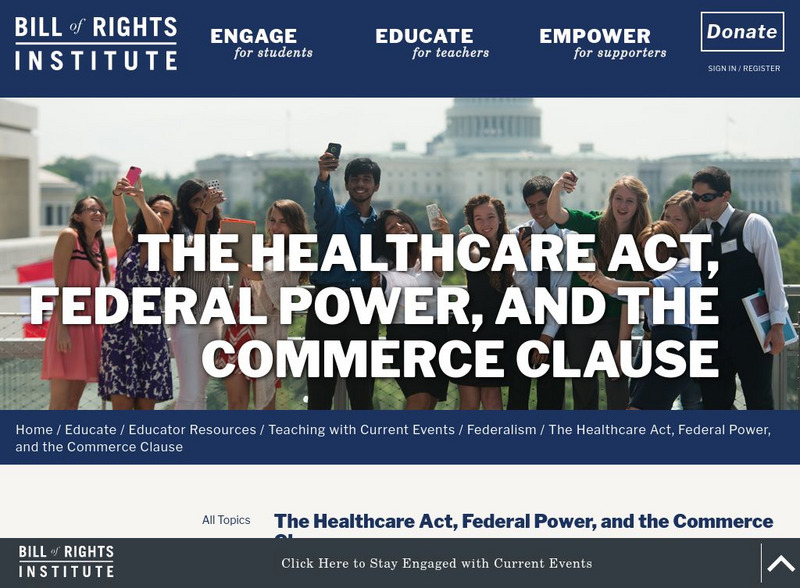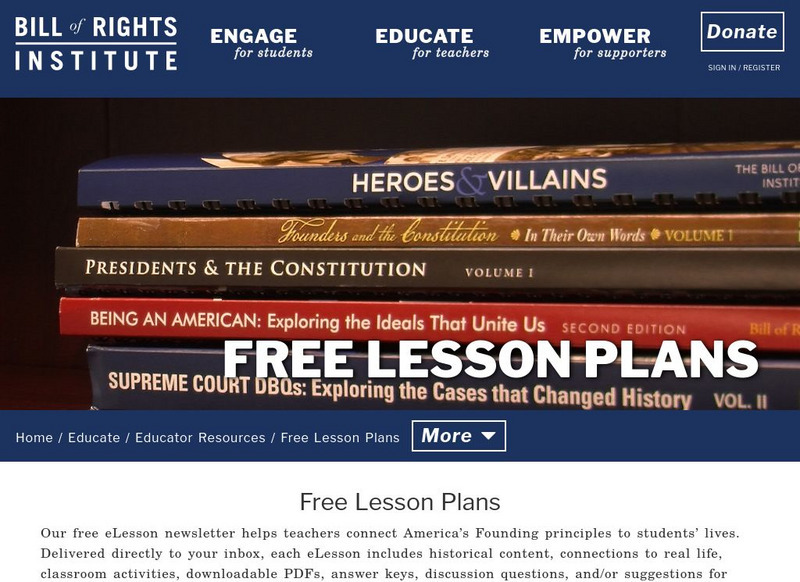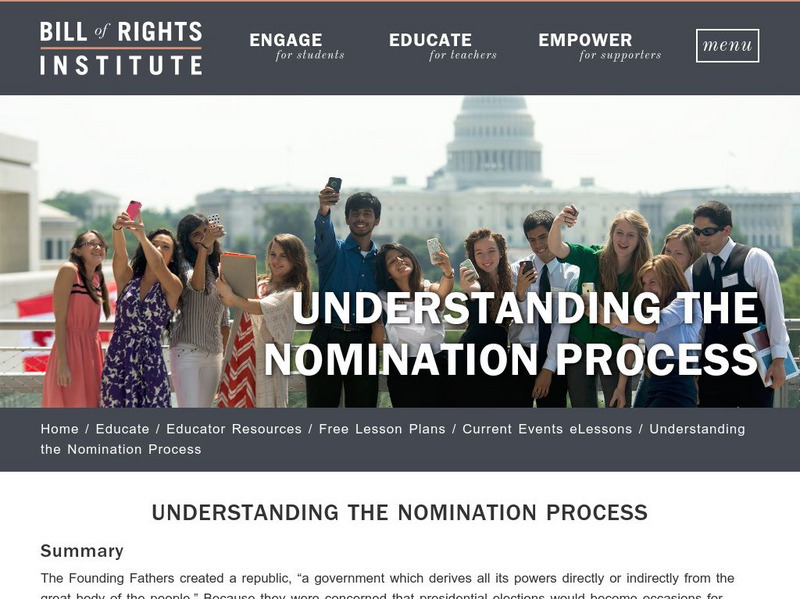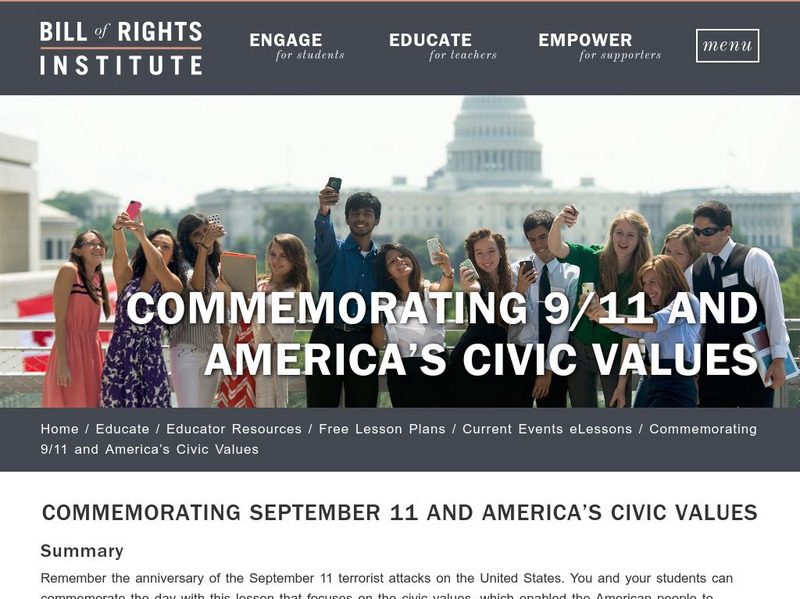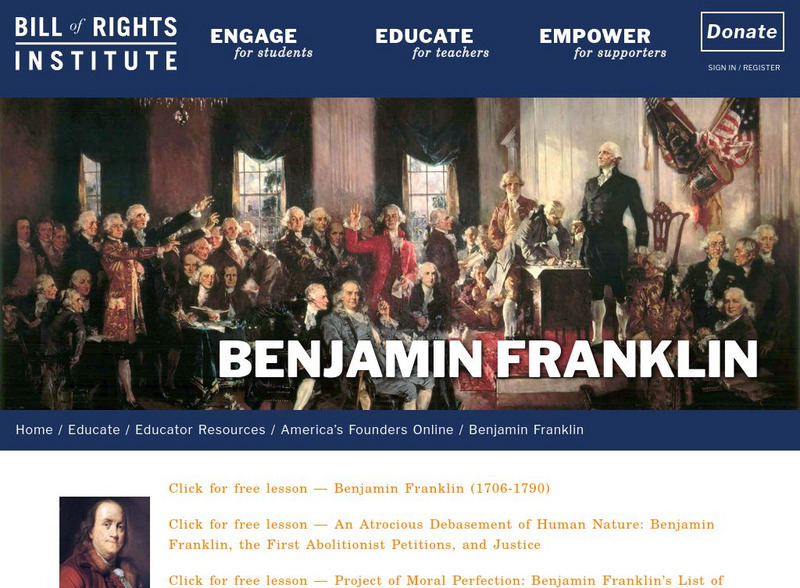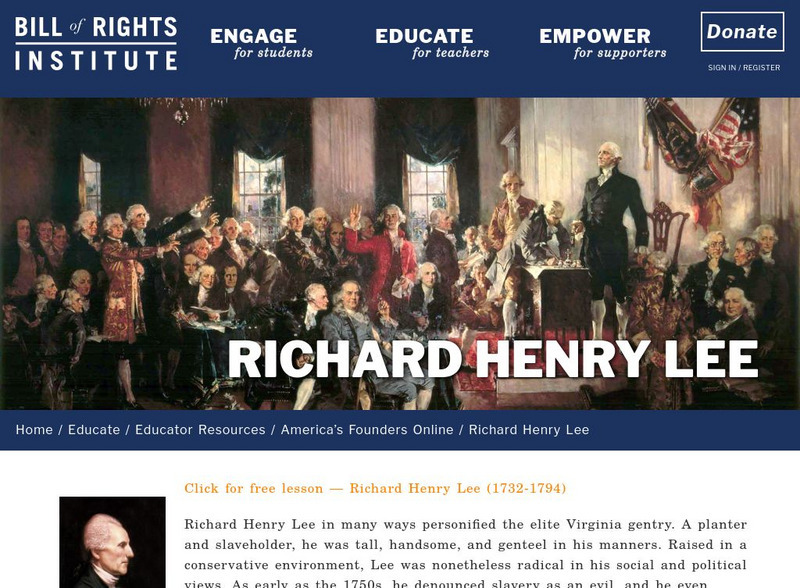Hi, what do you want to do?
Bill of Rights Institute
Bill of Rights Institute: Northwest Ordinance
Enacted through the Articles of Confederation, the Northwest Ordinance led to the organization of the Northwest Territory and expedited the expansion of the United States westward. This is a thorough explanation of the ordinance.
Bill of Rights Institute
Bill of Rights Institute: Healthcare Act, Federalism, and the Commerce Clause
Utilize a lesson plan focused on cases brought against the federal government based on part of the Affordable Healthcare Act.
Bill of Rights Institute
Bill of Rights Institute: Religious Freedom and the Affordable Healthcare Act
Summary, resources, and activities addressing the constitutionality with regard to the first amendment which surfaced with the Affordable Healthcare Act.
Bill of Rights Institute
Bill of Rights Institute: Property Rights and the Supreme Court
A question over a piece of property owned by one, yet deemed protected by the EPA prompted a court case in search of due process and protection of property rights. Find out more about the case and the process through this lesson plan.
Bill of Rights Institute
Bill of Rights Institute: Occupy Protests and the Bill of Rights
A lesson plan and extension activities focused on the Occupy Protests which began in 2011. Students will explore the goal of the protests in relationship to the Bill of Rights.
Bill of Rights Institute
The Bill of Rights Institute: Free Lesson Plans
Free lesson plans concerning the Bill of Rights and the freedoms guaranteed by the Constitution. Included are lessons on important news stories occurring today, as well as lessons on famous Americans and how they executed their rights.
Bill of Rights Institute
Bill of Rights Institute: The Federal Budget and the Constitution
What responsibilities belong to the U.S. President and the Congressional houses when it comes to establishing the federal budget? Take a look at these resources and incorporate this lesson plan into classroom learning.
Bill of Rights Institute
Bill of Rights Institute: Understanding the Nomination Process
From its conception in the United States Constitution, to necessary adjustments in the 12th Amendment, students will understand the nomination process and role of political parties in establishing a president with the aid of this lesson.
Bill of Rights Institute
Bill of Rights Institute: Justice Thomas on National Identity
An examination of a speech Justice Clarence Thomas delivered in 2009 highlighting his thoughts on the Bill of Rights as well has his views on the importance of American civic responsibility.
Bill of Rights Institute
Bill of Rights Institute: Commemorating 9/11 and America's Civic Values
A lesson plan which breaks down the events of September 11, 2001, particularly drawing attention to the civic responsibilities the victims shared and used to fight back against the terrorism they were living through.
Bill of Rights Institute
Bill of Rights Institute: Declaration of Independence
On June 7, 1776, Richard Henry Lee brought what came to be called the Lee Resolution before the Continental Congress. This resolution stated "these United Colonies are, and of right ought to be, free and independent states " Congress...
Bill of Rights Institute
Bill of Rights Institute: Additional Amendments
The Constitution contains within itself the process of changing it. The amendment process is described in Article 5. Amendments can be proposed in Congress when 2/3rd of both Houses agree. The states can play a role in proposing changes...
Bill of Rights Institute
Bill of Rights Institute: Constitutional Principles
James Madison knew that a key challenge of maintaining just government was framing it in such a way that the government would be forced to control itself. How does a system of separated powers-and the checks and balances built into those...
Bill of Rights Institute
Bill of Rights Institute: Founders Quotes
Liberty must at all hazards be supported. We have a right to it, derived from our Maker. But if we had not, our fathers have earned and bought it for us, at the expense of their ease, their estates, their pleasure, and their blood. -...
Bill of Rights Institute
Bill of Rights Institute: Abigail Adams
Abigail Smith Adams was born in Massachusetts, a descendant of the distinguished Quincy family. She married young lawyer John Adams in 1764. They settled on a farm in Braintree, Massachusetts. The couple had four surviving children,...
Bill of Rights Institute
Bill of Rights Institute: John Adams
Short, overweight, and quick-tongued, John Adams hardly fits the model of the typical Founder. But Adams's contributions to American independence and the formation of the United States government were great. Adams penned defenses of...
Bill of Rights Institute
Bill of Rights Institute: Charles Carroll
Charles Carroll is primarily remembered today for his political leadership in Maryland during the Revolutionary era. A wealthy planter, Carroll became a major figure in the patriot movement in 1773 when he penned the First Citizen...
Bill of Rights Institute
Bill of Rights Institute: John Dickinson
John Dickinson was called "The Penman of the American Revolution." During the 1760s and 1770s, he authored numerous important essays in defense of American rights, including The Late Regulations Respecting the British Colonies, the...
Bill of Rights Institute
Bill of Rights Institute: Benjamin Franklin
Although he was the old sage of the American Revolution and the Founding generation, Benjamin Franklin's considerable work in the areas of journalism, science, and invention often obscure his many contributions to the creation of the...
Bill of Rights Institute
Bill of Rights Institute: Elbridge Gerry
Elbridge Gerry is remembered today for his controversial attempt as governor to draw congressional districts in Massachusetts to the advantage of his party. Indeed, "gerrymandering" is a common political tactic today and undeniably part...
Bill of Rights Institute
Bill of Rights Institute: Alexander Hamilton
Alexander Hamilton is perhaps the most misunderstood and under-appreciated of the Founders. A proponent of a strong national government with an "energetic executive," he is sometimes described as the godfather of modern big government....
Bill of Rights Institute
Bill of Rights Institute: John Hancock
Forever famous for his outsized signature on the Declaration of Independence, John Hancock was a larger than life figure in other ways as well. Part of the great Boston triumvirate that included Samuel Adams and James Otis, Hancock was a...
Bill of Rights Institute
Bill of Rights Institute: John Jay
John Jay epitomized the selfless leader of the American Revolution. Born to a prominent New York family, John Jay gained notoriety as a lawyer in his home state. He favored a moderate approach to Britain but joined his fellow Patriots...
Bill of Rights Institute
Bill of Rights Institute: Richard Henry Lee
Richard Henry Lee in many ways personified the elite Virginia gentry. A planter and slaveholder, he was tall, handsome, and genteel in his manners. Raised in a conservative environment, Lee was nonetheless radical in his social and...






